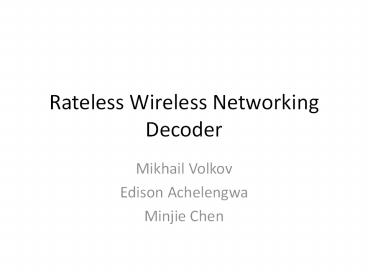Rateless Wireless Networking Decoder - PowerPoint PPT Presentation
Title:
Rateless Wireless Networking Decoder
Description:
After the backtrack memory is updated the Spine Evaluator needs to know what were the best suggestions on the pruned tree so that it can compute their corresponding ... – PowerPoint PPT presentation
Number of Views:73
Avg rating:3.0/5.0
Title: Rateless Wireless Networking Decoder
1
Rateless Wireless Networking Decoder
Mikhail Volkov Edison Achelengwa Minjie Chen
2
Cortex a rateless wireless system
- Very recent work here at CSAIL (Perry, 2011)
- Use a novel rateless code called spinal code
- Encoder and decoder agree on a seed s0, a hash
function h and an IQ constellation mapping
3
Spinal Encoder
- Wish to transmit a message M m1m2 ... mn
- Break the message into k-bit segments Mi
- Apply h to generate a spine
4
Spinal Encoder
- Encoder performs passes over the spine, each time
generating new constellation points - These constellation points are sent across an
AWGN channel
5
Spinal Decoder
- Decoder knows s0 so it can generate the 2k
possible candidate symbols s1 using h - Each time decoder receives symbol y it keeps the
B best symbols from 2k candidates using ML - The transmitted message is estimated as the one
with the lowest ML cost
6
Spinal Decoder
7
Objectives
- Implement decoder on an FPGA
- Evaluate feasibility of Cortex in a real
communications system - Identify key performance bottleneck and develop a
clear strategy for developing a practical Cortex
system
8
Micro-architecture
- Interface
- Takes stream of constellation symbols as input
- Outputs a message (192-bit packet)
- Decoding Stages
- Code Enumeration
- Add-Compare-Select
- Suggestion Update
- Spine Evaluator Update
- Get output message
9
Decoder
Input bit Streams
mkDecoder
I
toACSQ
updateSymQ
doACS
outbitsQ
Q
suggupd
Msg
Symbol
Vect(B2k, MarkedCost)
getOutMsg
out_msg (get)
Vect(B2k, EnumResp)
put
Sorting module
get
Vect(B, MarkedCost)
EnumReq
Msg
Schedule
get
put
Vect(B, MarkedCost)
getMsg
Spine Evaluator
getSchedule
updateTree
Puncturing Scheduler
backtrackMem
mkSalsa, h()
Symbol Mapper f()
getBestMsgs
evalupd
get
Vect(B, Mark)
seeding parameters
schedule params
10
Micro-architecture
- Sub-modules
- Puncturing Scheduler
- Spine Evaluator
- Sorter
- Backtrack Memory
11
Decoder
Input bit Streams
mkDecoder
I
toACSQ
updateSymQ
doACS
outbitsQ
Q
suggupd
Msg
Symbol
Vect(B2k, MarkedCost)
getOutMsg
out_msg (get)
Vect(B2k, EnumResp)
put
Sorting module
get
Vect(B, MarkedCost)
EnumReq
Msg
Schedule
get
put
Vect(B, MarkedCost)
getMsg
Spine Evaluator
getSchedule
updateTree
Puncturing Scheduler
backtrackMem
mkSalsa, h()
Symbol Mapper f()
getBestMsgs
evalupd
get
Vect(B, Mark)
seeding parameters
schedule params
12
Practical Salsa Implementation
- In practice we cannot have infinite precision
floating point numbers - Salsa produces two outputs a 64-bit spine and
512-bit arrays of symbol bits
13
Development and Testing
- 3 point development and testing plan
- Critical to our success with 3 people under time
constraints - Step 1 Develop Decoder backbone with dummy
Sorter and Spine Evaluator. Develop Sorter and
Spine Evaluator independently. - - Sorter tested with MATLAB.
- - Spine Evaluator (and Salsa) tested with Python.
14
Development and Testing
Step 2 Integrate Decoder with Sorter and Spine
Evaluator. Ensure correctness at the
architectural level - Modules instantiate
correctly - Rules fire as expected, no deadlocks
etc. - Timing is correct - Bits flowing
end-to-end
15
Development and Testing
Step 3 Ensure correctness at the semantic level,
i.e. bit-by-bit debugging
- Encode string with Python encoder to produce
symbols - Decode symbols and compare results
16
Development and Testing
- Finally, the algorithm was tested by adding noise
to the transmitted symbols - Strictly not our concern, as long as our
implementation agreed with the source code - Algorithm worked very well
- Actually outdid the reference code at one
point the Python code crashed but our decoder
correctly decoded the message!
17
Performance Analysis FPGA frequency
- The synthesized FPGA maximum frequency is 98.035
MHz. - Different Salsas gives the same FPGA frequency .
18
Performance Analysis Frequency, Latency,
Throughput
19
Performance Analysis - Area
- Sorter and SpineEvaluator take the most area
20
Performance Analysis - Area
- Our implementation actually fits on the FPGA.
(roughly taking 30 of the total area) - Different Salsa implementation dont vary too
much on device utilization.
21
Performance Analysis - Code
- The total lines of source code was 3104. Of
these, the total lines of test code was 1135
(36.5) and non-test code was 1969 (63.4).
22
How much better can we do?
- We used a naive O(n2) algorithm for the sorter
module. We might be able to use other algorithm
to reduce the cycle step from 149 to 32 in the
best case, which brings a 5 times better
performance and improve the bit rate ot
7.5Mbits/s. - Given the current space requirement of Salsa, we
can have B (B4) of seperate hashing modules
running in parallel with each other. In this
case, we can have 4 times of better performance
and improve the bit rates to 7.54 30 Mbits/s. - Suppose we have sufficient area on the FPGA, we
will be able to have B2k 32 of hash modules
running in parallel with each other . This will
bring 32 times of better performance and improve
the bit rates to 7.532 240Mbits/s.































